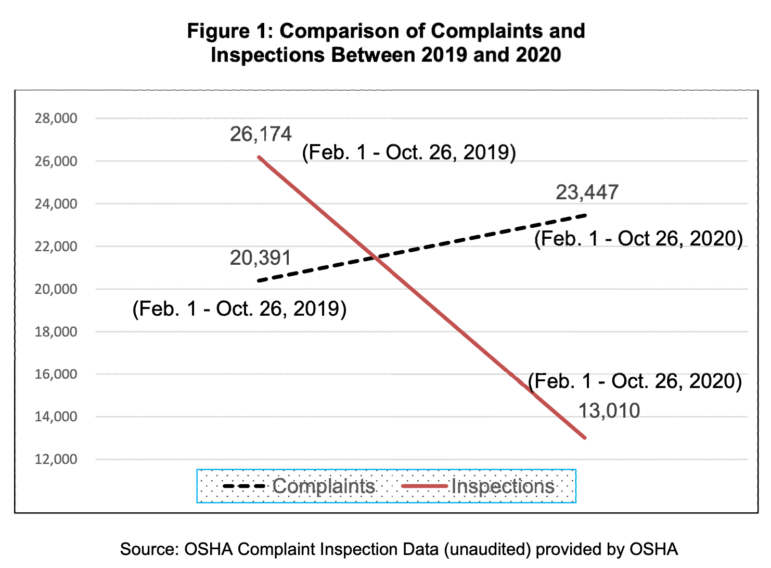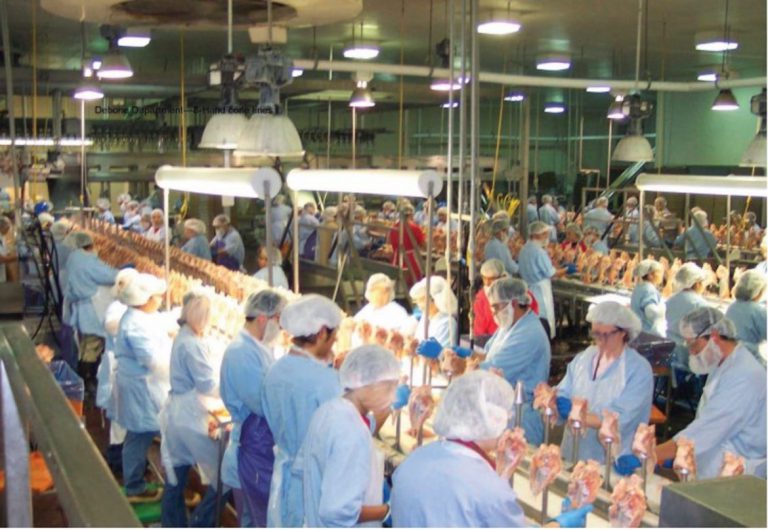The Occupational Safety and Health Administration’s decision during the COVID-19 pandemic to conduct many inspections virtually — instead of onsite — risked worker safety, the U.S. Department of Labor’s inspector general concluded in an audit report released Tuesday.
The report does not specifically mention OSHA’s enforcement at meatpacking plants, which quickly became COVID-19 hotspots last year, but the problems the report details have plagued the agency’s response to the industry.
“While remote inspections might help mitigate potential transmission of COVID-19,” the report said, “a reduction in onsite inspections could result in more worksite accidents, injuries, deaths, or employee illnesses.”
In addition to virtually inspecting workplaces, OSHA conducted far fewer inspections in general.
Total complaints increased 15% between Feb. 1 and Oct. 26 last year over the same period in 2019, but overall inspections — those related to COVID-19 and otherwise — decreased by 50%, according to the inspector general’s report.
“While some OSHA inspections have been done using entirely remote methods, OSHA inspectors have entered workplaces to conduct inspections, throughout the pandemic,” a DOL spokesperson told the Midwest Center on Tuesday. “OSHA will continue to conduct inspections using either onsite or a combination of onsite and remote methods, where it is safe to do so.”

[Read more: COVID-19 deaths go uninvestigated as OSHA takes a hands-off approach to meatpacking plants]
Onsite inspections have “historically resulted” in employers timely addressing problems OSHA identified, according to the report. And protection was available for OSHA employees who visited meatpacking plants.
When two OSHA inspectors started an inspection at the JBS pork plant in Marshalltown, Iowa, in May, the plant provided them with “face masks and Tyvek suits and booties,” according to an inspection report.
Under former President Donald Trump, OSHA took a hands-off approach to meatpacking plants.
In January, USA Today and the Midwest Center for Investigative Reporting found that OSHA had not inspected 40% of the plants where at least one employee had died of COVID-19. The agency said it had conducted 10 virtual inspections of meatpacking plants after reports of deaths.
OSHA waited months into the pandemic, and only after a well-publicized plant closing, to reach out to the USDA to coordinate the federal government’s response to COVID-19 in meatpacking plants. Hundreds of plants have had COVID-19 outbreaks, but OSHA has only fined 8 plants, according to the U.S. House of Representatives’ Select Subcommittee on Coronavirus Crisis.
Both agencies oversee the industry — USDA food inspectors work daily in the plants — but OSHA is responsible for worker safety.
Loren Sweatt, Trump’s head of OSHA, has consistently defended the agency’s approach during the pandemic.
“OSHA inspectors should be commended for conducting inspections under very trying and difficult circumstances,” she told the Midwest Center in an email Tuesday.
Do you work for OSHA now, or did you use to work for OSHA during the pandemic? Do you have information on how the agency approached enforcement of meatpacking plants, or approaching enforcement of meatpacking plants now? Email Sky Chadde at sky.chadde@investigatemidwest.org or MidwestCenter@protonmail.com.
The meatpacking industry pressured the USDA to keep plants running. Its lobbying arm, the North American Meat Institute, submitted a draft executive order to the agency that declared plants essential. Similar language appeared in the executive order Trump signed a week later.
At least 45,000 COVID-19 cases have been linked to meatpacking plants, and at least 243 workers have died, according to Midwest Center tracking.
The Biden administration has claimed it will address worker safety during the pandemic. In its response to the inspector general’s report, OSHA accepted all four of the report’s recommendations.
The inspector general recommended the agency 1) prioritize inspections of “high-risk” employers, which a DOL spokesperson said could include meatpacking plants; 2) track virtual inspections, even retroactively; 3) compare virtual and onsite inspections and each one’s effectiveness; and 4) “analyze and determine” whether an emergency temporary standard related to COVID-19 is “necessary.”
Unions and labor experts have said such a standard would help the agency enforce worker safety. On Jan. 21, his second day in office, President Biden ordered the agency to study whether to implement a temporary standard.
As of Wednesday, there has not been any announced temporary standard. A DOL spokesperson said, “OSHA is in the process of considering the need for an emergency temporary standard.”
The inspector general’s office interviewed a few OSHA inspectors for its report, and opinion was split on a temporary standard. One said it would make enforcement easier, but another said COVID-19 citations were inherently difficult because inspectors must prove that a person caught the virus at work.
OSHA entered the pandemic with its fewest number of inspectors and supervisors — 862 — in its 45-year history, according to records obtained by the National Employment Law Project. As of the end of February, its ranks had increased slightly, to 894, a DOL spokesperson said.
“The President is committed to increasing the number of OSHA inspectors,” the spokesperson said.

